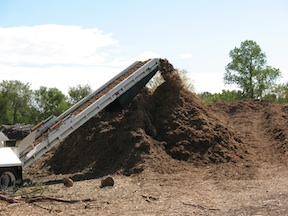
By B. Jackson, R. Schroeder, S. Ashton, and EL Taylor
Grinders are machines that reduce woody biomass particles in size by repeatedly pounding them into smaller pieces through a combination of tensile, shear and compressive forces. Most are derivatives of hammer mills and include horizontal feed grinders. Grinders accept a wider range of piece sizes. They will even accept short, non-oriented pieces including stumps, tops, brush, and large forked branches. Grinders rely on hitting a piece of wood often enough to finally break it into the piece size desired, usually with high speed rotating hammers. They require more energy than chippers per ton of output. Additionally, excessive soil contamination can increase internal wear.

In-woods grinding cost $14 – $18 per green ton and may constitute the greatest cost of the overall process. Currently, pyrolysis reactors require wood feedstocks to be processed by grinders in order to reduce chips to 3 mm or less. However, advanced pyrolysis reactors technology currently being researched (e.g., ablative) may tolerate feedstocks at 6 mm. This can be obtained with chipping and would eliminate the need for grinding.
Chipping/grinding costs can be further reduced by as much as 65% at a centralized facility with parasitic load from a electrical producing process of the facility.
